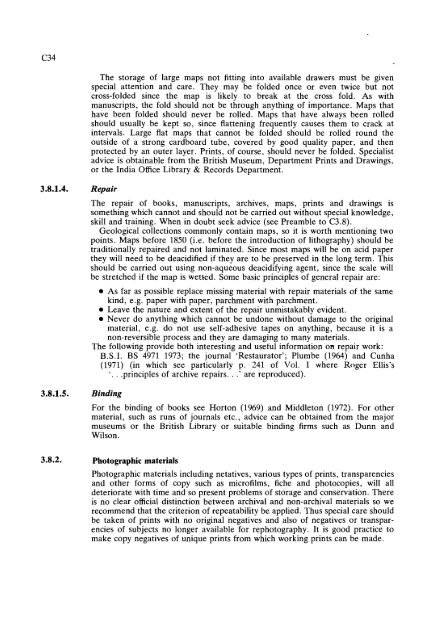GUIDELINES FOR THE CURATION OF GEOLOGICAL MATERIALS
GUIDELINES FOR THE CURATION OF GEOLOGICAL MATERIALS
GUIDELINES FOR THE CURATION OF GEOLOGICAL MATERIALS
Create successful ePaper yourself
Turn your PDF publications into a flip-book with our unique Google optimized e-Paper software.
3.8.1.4. Repair<br />
3.8.1.5. Binding<br />
The storage of large maps not fitting into available drawers must be given<br />
special attention and care. They may be folded once or even twice but not<br />
cross-folded since the map is likely to break at the cross fold. As with<br />
manuscripts, the fold should not be through anything of importance. Maps that<br />
have been folded should never be rolled. Maps that have always been rolled<br />
should usually be kept so, since flattening frequently causes them to crack at<br />
intervals. Large flat maps that cannot be folded should be rolled round the<br />
outside of a strong cardboard tube, covered by good quality paper, and then<br />
protected by an outer layer. Prints, of course, should never be folded. Specialist<br />
advice is obtainable from the British Museum, Department Prints and Drawings,<br />
or the India Office Library & Records Department.<br />
The repair of books, manuscripts, archives, maps, prints and drawings is<br />
something which cannot and should not be carried out without special knowledge,<br />
skill and training. When in doubt seek advice (see Preamble to C3.8).<br />
Geological collections commonly contain maps, so it is worth mentioning two<br />
points. Maps before 1850 (i.e. before the introduction of lithography) should be<br />
traditionally repaired and not laminated. Since most maps will be on acid paper<br />
they will need to be deacidified if they are to be preserved in the long term. This<br />
should be carried out using non-aqueous deacidifying agent, since the scale will<br />
be stretched if the map is wetted. Some basic principles of general repair are:<br />
As far as possible replace missing material with repair materials of the same<br />
kind, e.g. paper with paper, parchment with parchment.<br />
Leave the nature and extent of the repair unmistakably evident.<br />
Never do anything which cannot be undone without damage to the original<br />
material, e.g. do not use self-adhesive tapes on anything, because it is a<br />
non-reversible process and they are damaging to many materials.<br />
The following provide both interesting and useful information on repair work:<br />
B.S.I. BS 4971 1973; the journal 'Restaurator'; Plumbe (1964) and Cunha<br />
(1971) (in which see particularly p. 241 of Vol. I where Roger Ellis's<br />
'. . .principles of archive repairs. . .' are reproduced).<br />
For the binding of books see Horton (1969) and Middleton (1972). For other<br />
material, such as runs of journals etc., advice can be obtained from the major<br />
museums or the British Library or suitable binding firms such as Dunn and<br />
Wilson.<br />
3.8.2. Photographic materials<br />
Photographic materials including netatives, various types of prints, transparencies<br />
and other forms of copy such as microfilms, fiche and photocopies, will all<br />
deteriorate with time and so present problems of storage and conservation. There<br />
is no clear official distinction between archival and non-archival materials so we<br />
recommend that the criterion of repeatability be applied. Thus special care should<br />
be taken of prints with no original negatives and also of negatives or transparencies<br />
of subjects no longer available for rephotography. It is good practice to<br />
make copy negatives of unique prints from which working prints can be made.

















